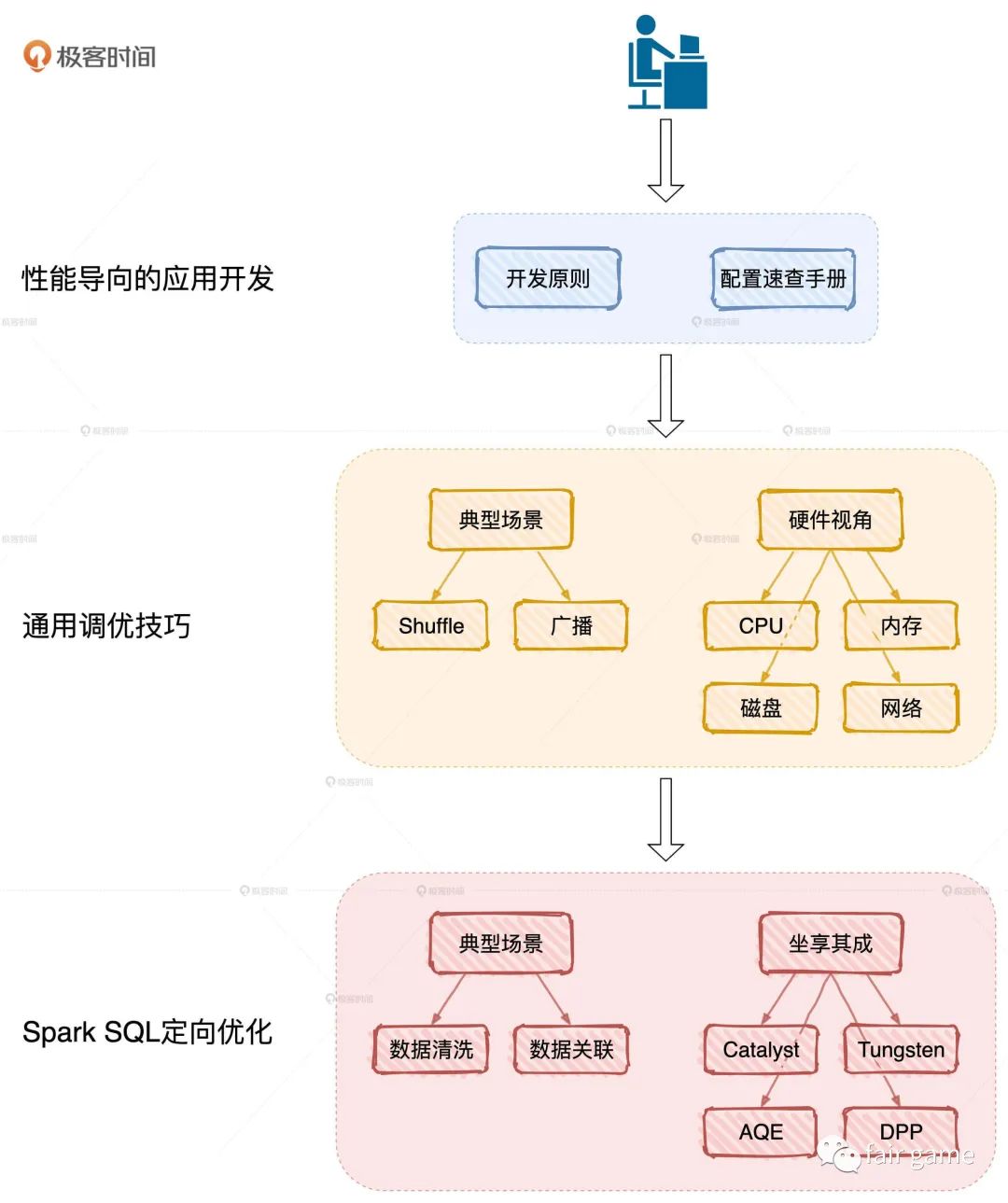需要我们深入Spark的核心原理,不断去尝试每一个API,算子,设置不同的配置参数,最终找到最佳的排列组合

小🌰 1:
//实现方案1 —— 反例val extractFields: Seq[Row] => Seq[(String, Int)] = {(rows: Seq[Row]) => {var fields = Seq[(String, Int)]()rows.map(row => {fields = fields :+ (row.getString(2), row.getInt(4))})fields}}
函数式编程范式:原则之一就是尽可能在函数体中避免副作用—-函数对于状态的修改和变更
//实现方案2 —— 正例val extractFields: Seq[Row] => Seq[(String, Int)] = {(rows: Seq[Row]) =>rows.map(row => (row.getString(2), row.getInt(4))).toSeq}
小🌰 2:
//实现方案1 —— 反例def createInstance(factDF: DataFrame, startDate: String, endDate: String): DataFrame = {val instanceDF = factDF.filter(col("eventDate") > lit(startDate) && col("eventDate") <= lit(endDate)).groupBy("dim1", "dim2", "dim3", "event_date").agg(sum("value") as "sum_value")instanceDF}pairDF.collect.foreach{case (startDate: String, endDate: String) =>val instance = createInstance(factDF, startDate, endDate)val outPath = s"${rootPath}/endDate=${endDate}/startDate=${startDate}"instance.write.parquet(outPath)}
- collect是将结果收集到Driver端的操作,Driver可能形成单点瓶颈
- pariDF.collect后foreach,每一次循环都会扫全量factDF ```scala //实现方案2 —— 正例 val instances = factDF .join(pairDF, factDF(“eventDate”) > pairDF(“startDate”) && factDF(“eventDate”) <= pairDF(“endDate”)) .groupBy(“dim1”, “dim2”, “dim3”, “eventDate”, “startDate”, “endDate”) .agg(sum(“value”) as “sum_value”)
instances.write.partitionBy(“endDate”, “startDate”).parquet(rootPath)
<a name="JURK5"></a>### 常规操作1. 对多次使用的RDD进行持久化1. 尽可能避免使用shuffle类算子:尽可能避免使用reduceByKey, join(可采用 Broadcast Join), distinct, repartition1. 尽量使用map-side预聚合的算子reduceByKey代替groupByKey1. 使用高性能算子Filter + Coalesce和mapPartitions代替map<br />foreachPartitions代替foreach5. 广播大变量<a name="P8q16"></a>### 能省则省,能拖则拖<br /><br />1. 尽量把能节省数据扫描量和数据处理量的操作往前推1. 尽力消灭Shuffle,省去数据罗盘与分发的开销1. 如果不能干掉Shuffle,尽可能把涉及Shuffle的操作拖到最后去执行🌰```scalaval dates: List[String] = List("2020-01-01", "2020-01-02", "2020-01-03")val rootPath: String = _//读取日志文件,去重、并展开userInterestListdef createDF(rootPath: String, date: String): DataFrame = {val path: String = rootPath + dateval df = spark.read.parquet(path).distinct.withColumn("userInterest", explode(col("userInterestList")))df}//提取字段、过滤,再次去重,把多天的结果用union合并val distinctItems: DataFrame = dates.map{case date: String =>val df: DataFrame = createDF(rootPath, date).select("userId", "itemId", "userInterest", "accessFreq").filter("accessFreq in ('High', 'Medium')").distinctdf}.reduce(_ union _)
优化后
val dates: List[String] = List("2020-01-01", "2020-01-02", "2020-01-03")val rootPath: String = _val filePaths: List[String] = dates.map(rootPath + _)/**一次性调度所有文件先进行过滤和列剪枝然后再展开userInterestList最后统一去重*/val distinctItems = spark.read.parquet(filePaths: _*).filter("accessFreq in ('High', 'Medium'))").select("userId", "itemId", "userInterestList").withColumn("userInterest", explode(col("userInterestList"))).select("userId", "itemId", "userInterest").distinctval ds: Dataset[Row] = df.mapPartitions(iterator => {val util = new Util() // 实例化Util的操作不需要那么多次val res = iterator.map{case row=>{val s: String = row.getString(0) + row.getString(1) + row.getString(2)val hashKey: String = util.md5.digest(s.getBytes).map("%02X".format(_)).mkString(hashKey, row.getInt(3)) }}res})import java.security.MessageDigestclass Util {val md5: MessageDigest = MessageDigest.getInstance("MD5")val sha256: MessageDigest = _ //其他哈希算法}

